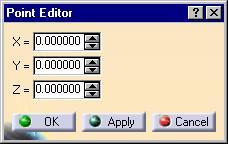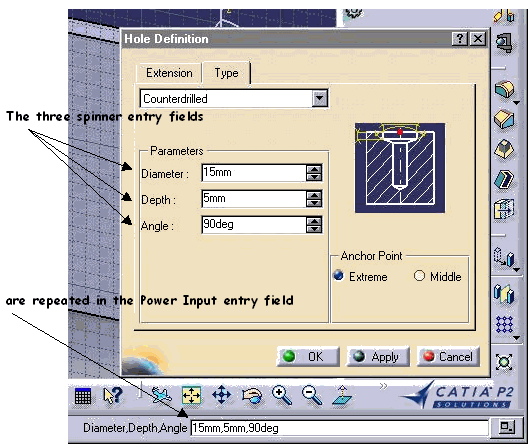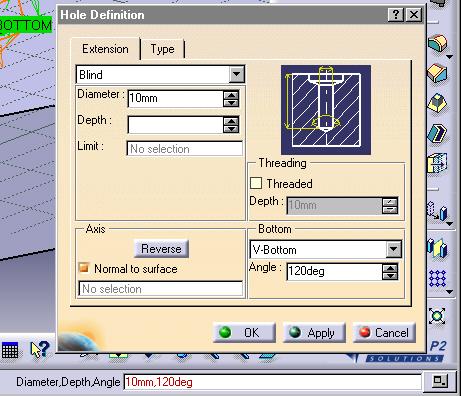
3D PLM Enterprise Architecture |
User Interface - Commands |
Using a Dialog Box as InputHow to take end user input from a dialog window |
| Technical Article | ||
AbstractThis article shows the different ways of using a dialog box to input values used by a dialog command. |
Using a dialog box as input for a state dialog command is a very common way
to get many parameters at the same time. This is possible thanks to a dialog
agent created and plugged to the state that displays the dialog box. The dialog
agent behavior should be modified using the AcceptOnNotify method
in order to value the dialog agent, that is accept the end user input and
trigger the transition, when, for example, the end user clicks the OK button in
the dialog box.
 |
For example, a command that creates 3D points can use a dialog box to input the point X,Y, and Z coordinates. |
To do this, you should create the dialog box and the dialog agent, set the
dialog agent behavior, plug the dialog agent to the state, and create the
transition in the BuildGraph method.
[Top]
The Point Editor dialog box is created using a class that derives from the CATDlgDialog
class that groups three labels and three spinners, and that features the OK,
Apply, and Cancel buttons. This class is instantiated in the BuildGraph
method and is made visible for the appropriate state.
... _pPointEditor = new CAAPointEditor(); _pPointEditor->Build(); ... |
[Top]
The dialog agent is created as an instance of the CATDialogAgent class.
...
_pdaEditorAgent = new CATDialogAgent("PointEditorId");
...
|
[Top]
The dialog agent behavior must be set in order to value the dialog agent when
the end user clicks the OK button of the Point Editor. This is done by using the
AcceptOnNotify method to which the point editor instance, that is,
the notifier, is passed as first parameter, and the notification to react to as
second parameter.
...
_pdaEditorAgent->AcceptOnNotify(_pPointEditor,
_pPointEditor->GetDiaOKNotification());
...
|
The object that sends the notification must always be used. Here, however, this is not the OK push button, but the point editor dialog box, because the dialog box class derives from CATDlgDialog that sends itself the notifications for its OK, Apply, or Cancel push buttons.
Once properly configured the _daEditorAgent dialog agent is used
like any other dialog agent: it must be plugged to a dialog state using the AddDialogAgent
method before being used in the guard condition as a parameter of the IsOutputSetCondition
method.
...
pSourceState->AddDialogAgent(_pdaEditorAgent);
...
AddTransition(pSourceState, pTargetState,
AndCondition(
IsOutputSetCondition(_pdaEditorAgent),
...
Action(
(ActionMethod) & CAACommandCmd::CreatePointByBox));
...
|
The CreatePointByBox action method uses _pPointEditor,
the pointer to the dialog box, to retrieve input values. This method should
either know the dialog box content to ask the controls to return their value.
The dialog box can also explore a method to enable any object to retrieve these
values.
[Top]
The Power Input mode lets the end user enter several values requested by editors or spinners of a dialog box in a single entry field of the main application window when the P2 style is selected. For example, the figure below shows the Hole creation dialog box and how it uses the Power Input field.

The three spinner entry fields are repeated and concatenated in the status bar:
When the field content doesn't match the expected one, it displayed in red.

For example, on the figure above, three fields are expected, and only two are provided.
To enable your dialog box to use the Power Input for its editors and
spinners, create this box using the CATDlgPowerInputLink style.
This will automatically enable all the descending editors and spinners to take
advantage of the Power Input. This capability can be limited to a part of a
dialog box, such as the editors and spinners contained in a frame. To do this,
use the CATDlgPowerInputLink style in the frame constructor instead
of using it in the dialog box constructor.
You can dynamically set or reset the Power Input capability using the SetPowerInputLink
method. You need to call the UpdatePowerInput method just after to
update the Power Input prompt and entry field.
... _PointEditor->SetPowerInputLink(0); // disable _PointEditor->UpdatePowerInput(); ... _PointEditor->SetPowerInputLink(1); //enable _PointEditor->UpdatePowerInput(); ... |
A single dialog box can use the Power Input at a time. If several dialog
boxes that enable the Power Input mode are simultaneously displayed, you must
select the one that will use the Power Input using the TakePowerInputFocus
method and disable the others using the ReleasePowerInputFocus
method.
[Top]
A dialog state command is a dialog command designed as a state machine, each state enabling end user input, that enables the end user to pass from state to state using transitions between these states triggered when requested events happen and when requested guard conditions are satisfied, and that execute the declared actions. It is modeled using a class deriving from the CATStateCommand class.
The statechart diagram is implemented using the BuildGraph
method, and the command life cycle is managed by the Activate, Desactivate,
and Cancel methods in addition to the command class constructor and
destructor.
[Top]
| Version: 1 [Jan 2000] | Document created |
| [Top] | |
Copyright © 2000, Dassault Systèmes. All rights reserved.